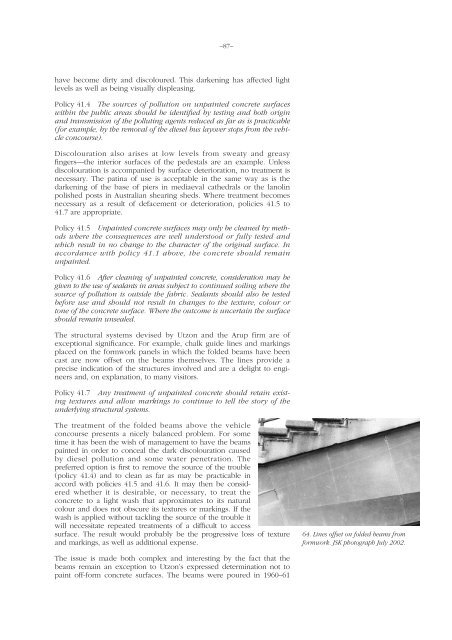Sydney Opera House conservation plan
Sydney Opera House conservation plan
Sydney Opera House conservation plan
You also want an ePaper? Increase the reach of your titles
YUMPU automatically turns print PDFs into web optimized ePapers that Google loves.
–87–have become dirty and discoloured. This darkening has affected lightlevels as well as being visually displeasing.Policy 41.4 The sources of pollution on unpainted concrete surfaceswithin the public areas should be identified by testing and both originand transmission of the polluting agents reduced as far as is practicable(for example, by the removal of the diesel bus layover stops from the vehicleconcourse).Discolouration also arises at low levels from sweaty and greasyfingers—the interior surfaces of the pedestals are an example. Unlessdiscolouration is accompanied by surface deterioration, no treatment isnecessary. The patina of use is acceptable in the same way as is thedarkening of the base of piers in mediaeval cathedrals or the lanolinpolished posts in Australian shearing sheds. Where treatment becomesnecessary as a result of defacement or deterioration, policies 41.5 to41.7 are appropriate.Policy 41.5 Unpainted concrete surfaces may only be cleaned by methodswhere the consequences are well understood or fully tested andwhich result in no change to the character of the original surface. Inaccordance with policy 41.1 above, the concrete should remainunpainted.Policy 41.6 After cleaning of unpainted concrete, consideration may begiven to the use of sealants in areas subject to continued soiling where thesource of pollution is outside the fabric. Sealants should also be testedbefore use and should not result in changes to the texture, colour ortone of the concrete surface. Where the outcome is uncertain the surfaceshould remain unsealed.The structural systems devised by Utzon and the Arup firm are ofexceptional significance. For example, chalk guide lines and markingsplaced on the formwork panels in which the folded beams have beencast are now offset on the beams themselves. The lines provide aprecise indication of the structures involved and are a delight to engineersand, on ex<strong>plan</strong>ation, to many visitors.Policy 41.7 Any treatment of unpainted concrete should retain existingtextures and allow markings to continue to tell the story of theunderlying structural systems.The treatment of the folded beams above the vehicleconcourse presents a nicely balanced problem. For sometime it has been the wish of management to have the beamspainted in order to conceal the dark discolouration causedby diesel pollution and some water penetration. Thepreferred option is first to remove the source of the trouble(policy 41.4) and to clean as far as may be practicable inaccord with policies 41.5 and 41.6. It may then be consideredwhether it is desirable, or necessary, to treat theconcrete to a light wash that approximates to its naturalcolour and does not obscure its textures or markings. If thewash is applied without tackling the source of the trouble itwill necessitate repeated treatments of a difficult to accesssurface. The result would probably be the progressive loss of texture 64. Lines offset on folded beams fromand markings, as well as additional expense. formwork. JSK photograph July 2002.The issue is made both complex and interesting by the fact that thebeams remain an exception to Utzon’s expressed determination not topaint off-form concrete surfaces. The beams were poured in 1960–61
















